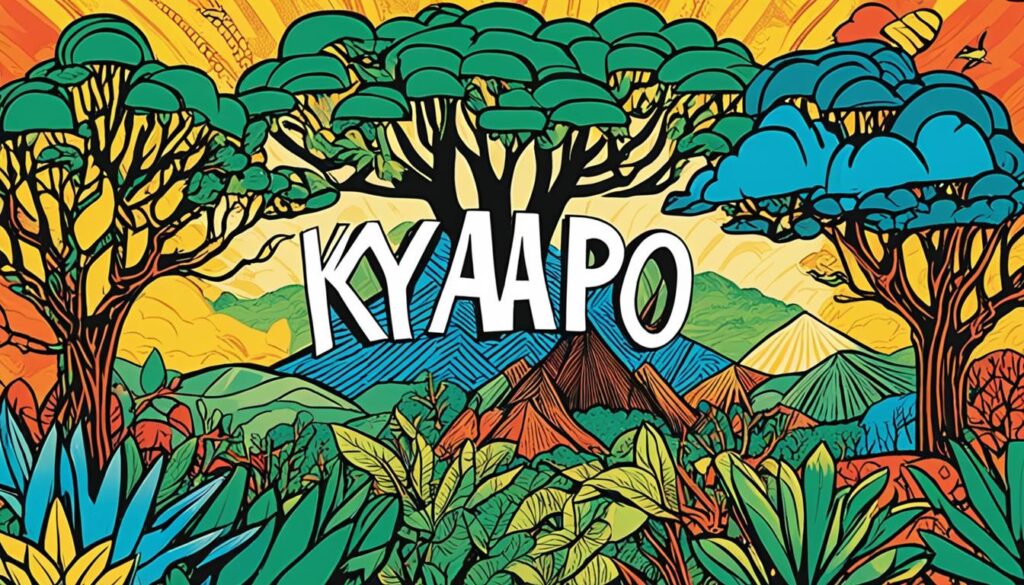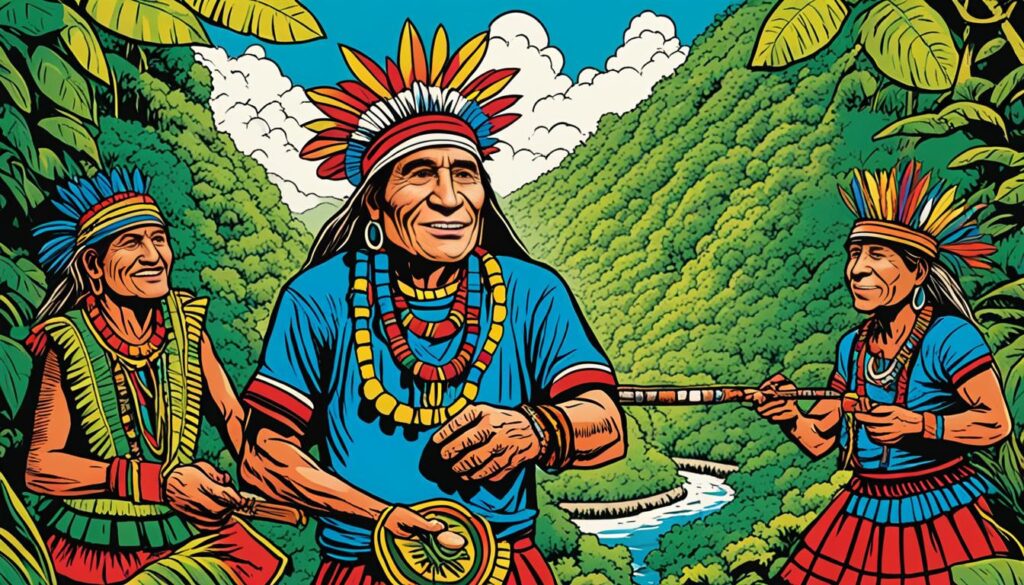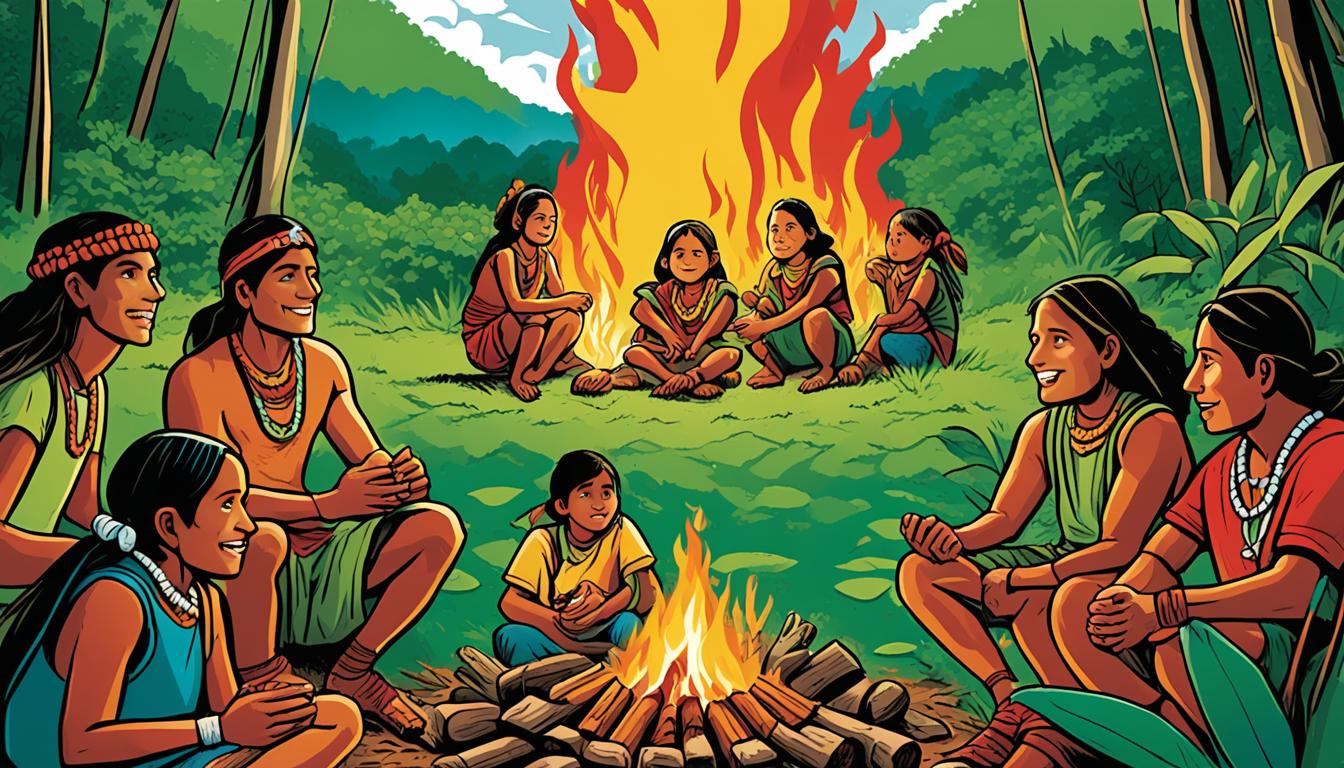Did you know that the Kayapó language, spoken by the Kayapó and Xikrin people, is classified as an endangered language in Brazil? With only around 8,600 native speakers as of 2010, the survival of this indigenous language is at stake. The linguistic diversity of the Amazon region is under threat, and efforts are being made to document and preserve the Kayapó language to safeguard Brazil’s rich cultural heritage.
Kayapó Language: A Vital Element of Indigenous Culture
The Kayapó language, also known as Mẽbêngôkre, holds great significance within the indigenous culture of the Kayapó and Xikrin people. It serves as a unifying force, connecting the various groups despite the differences in dialects. This linguistic diversity reflects the rich tapestry of indigenous languages found in Brazil, contributing to the country’s cultural heritage.
For the Kayapó, their language is not only a means of communication but a cherished part of their identity. The art of oratory holds immense value in their society, with skilled speakers admired and respected. The ability to speak well is seen as a virtue, distinguishing the Kayapó language from other indigenous groups.
“Our language is our way of expressing ourselves, preserving our history, and strengthening our bond as a community. It is the essence of who we are as Kayapó people.”
The Kayapó language, with its unique linguistic features and expressive qualities, is deeply intertwined with the traditions, beliefs, and values of the Kayapó and Xikrin people. It is through their language that their oral history, cultural practices, and ancestral knowledge are passed down through generations.
Preserving Linguistic Diversity and Indigenous Culture
In today’s rapidly changing world, preserving indigenous languages like the Kayapó language becomes crucial for maintaining cultural diversity. Language preservation efforts involve documenting and archiving the language, developing educational materials, and promoting language revitalization initiatives within the community.
Through these preservation efforts, the Kayapó people are able to safeguard their cultural heritage and ensure the continuity and vibrancy of their language. By valuing and preserving their language, they assert their indigenous identity and foster a sense of pride and belonging for present and future generations.
The History and Ethnography of the Kayapó Language
The Kayapó language, known as Mẽbêngôkre, has a rich cultural history and is an essential part of the indigenous heritage of Brazil. Its origins can be traced back to the late 19th century when the French explorer Henri Coudreau made contact with the Irã’ãmrãnhre group, who were speakers of Mẽbêngôkre.
Following Coudreau’s initial encounter, missionaries arrived in the region and played a crucial role in documenting the Kayapó language and culture. Their efforts contributed to the preservation and understanding of this unique indigenous language.
Unfortunately, the Kayapó people experienced significant challenges and tragic consequences as a result of their contact with outsiders. This contact led to the decline of certain Kayapó groups and a loss of linguistic and cultural diversity.
Despite these challenges, linguists and anthropologists have dedicated themselves to documenting the Kayapó language and have painstakingly built a body of knowledge about the Kayapó people and their culture. Through their efforts, we have gained invaluable insights into the linguistic features, cultural practices, and ethnographic aspects of the Kayapó community.
“The documentation of the Kayapó language and culture by linguists and anthropologists has paved the way for a deeper understanding of the indigenous group and their unique cultural heritage.”
Through ethnographic research, we have gained insights into the social structure, traditions, and rituals of the Kayapó people. This research has shed light on their deep connection to the land and their complex kinship systems.
An understanding of the Kayapó language and culture has not only contributed to our knowledge of linguistic diversity but has also helped establish the cultural significance of indigenous languages in Brazil. It is through the preservation and celebration of languages like Mẽbêngôkre that we can appreciate and protect the rich cultural heritage of indigenous communities.

| Key Points | Details |
|---|---|
| Linguistic Features | Mẽbêngôkre has a complex phonological inventory, including 16 consonants and 17 vowels. It is characterized by its oral and nasal vowels, voiced oral stops, and distinctive diphthongs. |
| Cultural Significance | The Kayapó language plays a vital role in shaping cultural identity and is closely intertwined with their oral traditions, mythologies, and social practices. They define themselves as “those who speak well.” |
| Ethnographic Insights | Through ethnographic research, we have gained insights into the social structure, traditions, and rituals of the Kayapó people, enhancing our understanding of their unique cultural heritage. |
Phonology and Syllable Structure of the Kayapó Language
The Kayapó language, also known as Mẽbêngôkre, exhibits a distinct phonological inventory consisting of 16 consonants and 17 vowels. This indigenous language spoken by the Kayapó and Xikrin people in Brazil showcases unique features and a rich syllable structure.
Vowel Inventory
The Kayapó language comprises both oral and nasal vowels, totaling 17 in number. These vowels contribute to the linguistic diversity and expressive potential of the language.
Consonant Inventory
Kayapó has 16 consonant sounds, including voiced and voiceless stops, fricatives, nasals, and approximants.
Distinctive Features
Among the Northern Jê languages, Kayapó stands out for its characteristic voiced oral stops and a series of diphthongs. These features contribute to the distinctiveness and complexity of the language.
Syllable Structure
The syllable structure of Kayapó can be described by the maximal syllable /CCCVC/, allowing for various consonant combinations in complex onsets. The stress pattern is fixed on the final syllable, enhancing the rhythm and melody of the language.
| Vowel Inventory | 17 vowels |
|---|---|
| Consonant Inventory | 16 consonants |
| Distinctive Features | Voiced oral stops, diphthongs |
| Maximal Syllable Structure | /CCCVC/ |
| Stress Pattern | Fixed on the final syllable |
The phonology and syllable structure of the Kayapó language contribute to its unique identity and linguistic richness. Through these phonetic elements, the Kayapó people express their cultural heritage and oral traditions, showcasing the importance of language preservation for future generations.
Kayapó Language and Cultural Identity
The Kayapó language holds immense significance in shaping the cultural identity of the Kayapó and Xikrin people. It serves as a unifying factor among different Kayapó groups while appreciating the unique characteristics that exist within the broader ethnic community. The language plays a crucial role in connecting individuals to their heritage and reinforcing a collective sense of belonging.
Linguistic unity is recognized and celebrated among the Kayapó and Xikrin people. They value the ability to speak well and consider it a virtue within their society. Oral communication is highly regarded, and the art of oratory is deeply interwoven into their cultural fabric. Skillful speakers possess the power to captivate audiences, preserve history, and transmit knowledge through captivating storytelling.
The preservation of the Kayapó language contributes to the perpetuation of oral traditions and mythologies that define and strengthen their cultural identity. Through the mastery of their language, the Kayapó people uphold their ancestral knowledge, wisdom, and values that have been passed down through generations. Oral traditions serve as a repository of their history, preserving cultural heritage, spirituality, and customary practices that shape their way of life.
Quotes:
“Our language is not just a means of communication; it is the essence of who we are. It connects us to our ancestors, our land, and our traditions.” – Elder of the Kayapó and Xikrin people
| Kayapó Language and Cultural Identity | |
|---|---|
| Linguistic Unity | The Kayapó and Xikrin people recognize the linguistic unity that exists among their diverse groups. |
| Oral Traditions | The Kayapó have a rich heritage of oral traditions and mythologies that reinforce their cultural identity. |
| Preservation of Ancestral Knowledge | Through the Kayapó language, ancestral knowledge, wisdom, and values are preserved and transmitted across generations. |

Conclusion
The Kayapó language, also known as Mẽbêngôkre, is a vital element of indigenous culture in Brazil. With efforts being made to preserve and document this endangered language, the Kayapó people’s linguistic diversity and cultural practices play a crucial role in enriching Brazil’s indigenous heritage.
The Kayapó language is deeply intertwined with the identity of the Kayapó and Xikrin communities, uniting them and distinguishing their language from others. Oratory holds significant importance, with the ability to speak well regarded as a virtue among the Kayapó people.
Efforts in language preservation and cultural preservation are imperative to ensure the longevity of the Kayapó language and culture in the Amazon region. By documenting and protecting the Kayapó language, future generations will have the opportunity to learn and appreciate this unique indigenous language, contributing to the broader linguistic diversity and cultural preservation of Brazil.
FAQ
What is the Kayapó language?
The Kayapó language, also known as Mẽbêngôkre, is a Northern Jê language spoken by the Kayapó and Xikrin people in the Pará and Mato Grosso regions of Brazil.
How many native speakers does the Kayapó language have?
As of 2010, the Kayapó language is estimated to have around 8,600 native speakers.
Why is the Kayapó language classified as endangered?
The limited materials for literacy and education in the Kayapó language pose challenges for language preservation efforts, leading to its classification as endangered.
What is the significance of the Kayapó language in indigenous culture?
The Kayapó language is an integral part of the indigenous culture of the Kayapó and Xikrin people. It plays a significant role in shaping cultural identity and is highly valued, with oratory being a cherished social practice among the Kayapó.
What is the history of the Kayapó language?
The Kayapó language’s history can be traced back to the late 19th century when the French explorer Henri Coudreau made contact with the Mẽbêngôkre-speaking Irã’ãmrãnhre group. Missionaries who arrived later played a role in documenting the language and culture.
What is the phonological inventory and syllable structure of the Kayapó language?
The Kayapó language has 16 consonants and 17 vowels, including both oral and nasal vowels. It has a unique feature among Northern Jê languages, with voiced oral stops and a series of diphthongs. The maximal syllable structure is /CCCVC/, with various consonant combinations allowed in complex onsets.
How does the Kayapó language contribute to cultural identity?
The Kayapó language contributes to cultural identity among the Kayapó and Xikrin people. They recognize the linguistic unity amongst their groups while acknowledging the differences. Oratory and oral traditions are highly valued, reinforcing their cultural identity.
What efforts are being made to preserve the Kayapó language?
Efforts are being made to preserve and document the Kayapó language for future generations. Linguists and anthropologists have played a role in documenting the language and cultural practices of the Kayapó people. Continued efforts in language preservation and cultural preservation are essential.
How does the Kayapó language contribute to linguistic diversity in Brazil?
The Kayapó language is one of the many indigenous languages in Brazil and contributes to the country’s linguistic diversity. Its preservation and documentation are vital for maintaining cultural richness and indigenous heritage in the Amazon region.
